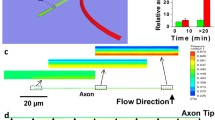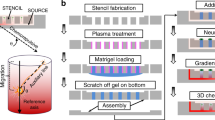Abstract
Microfluidics can be used to generate flow-driven gradients of chemotropic guidance cues with precisely controlled steepnesses for indefinite lengths of time. Neuronal cells grown in the presence of these gradients can be studied for their response to the effects exerted by the cues. Here we describe a polydimethylsiloxane (PDMS) microfluidics chamber capable of producing linear gradients of soluble factors, stable for at least 18 h, suitable for axon guidance studies. Using this device we demonstrate turning of superior cervical ganglion axons by gradients of nerve growth factor (NGF). The chamber produces robust gradients, is inexpensive to mass produce, can be mounted on a tissue culture dish or glass coverslip for long term time-lapse microscopy imaging, and is suitable for immunostaining.
Access this chapter
Tax calculation will be finalised at checkout
Purchases are for personal use only
Similar content being viewed by others
References
Engle EC (2010) Human genetic disorders of axon guidance. Cold Spring Harb Perspect Biol 2:a001784
Tessier-Lavigne M, Placzek M, Lumsden AG et al (1988) Chemotropic guidance of developing axons in the mammalian central nervous system. Nature 336:775–778
Rosoff WJ, Urbach JS, Esrick MA et al (2004) A new chemotaxis assay shows the extreme sensitivity of axons to molecular gradients. Nat Neurosci 7:678–682
Pujic Z, Giacomantonio CE, Unni D et al (2008) Analysis of the growth cone turning assay for studying axon guidance. J Neurosci Methods 170:220–228
Lohof AM, Quillan M, Dan Y, Poo MM (1992) Asymmetric modulation of cytosolic cAMP activity induces growth cone turning. J Neurosci 12:1253–1261
Yam PT, Langlois SD, Morin S, Charron F (2009) Sonic hedgehog guides axons through a noncanonical, Src-family-kinase-dependent signaling pathway. Neuron 62:349–362
Dupin I, Dahan M, Studer V (2013) Investigating axonal guidance with microdevice-based approaches. J Neurosci 33:17647–17655
Whitesides GM (2006) The origins and the future of microfluidics. Nature 442:368–373
Kothapalli CR, van Veen E, de Valence S et al (2011) A high-throughput microfluidic assay to study neurite response to growth factor gradients. Lab Chip 11:497–507
Wang JC, Li X, Lin B et al (2008) A microfluidics-based turning assay reveals complex growth cone responses to integrated gradients of substrate-bound ECM molecules and diffusible guidance cues. Lab Chip 8:227–237
Morel M, Shynkar V, Galas JC et al (2012) Amplification and temporal filtering during gradient sensing by nerve growth cones probed with a microfluidic assay. Biophys J 103:1648–1656
Lu H, Koo LY, Wang WM et al (2004) Microfluidic shear devices for quantitative analysis of cell adhesion. Anal Chem 76:5257–5264
Day MA (1990) The no-slip condition of fluid dynamics. Erkenntnis 33:285–296
Bhattacharjee N, Li N, Keenan TM, Folch A (2010) A neuron-benign microfluidic gradient generator for studying the response of mammalian neurons towards axon guidance factors. Integr Biol (Camb) 2:669–679
Campbell K, Groisman A (2007) Generation of complex concentration profiles in microchannels in a logarithmically small number of steps. Lab Chip 7:264–272
Mortimer D, Feldner J, Vaughan T et al (2009) Bayesian model predicts the response of axons to molecular gradients. Proc Natl Acad Sci U S A 106:10296–10301
Acknowledgements
We thank Jiajia Yuan for help with an earlier version of the microfluidics chamber . We gratefully acknowledge support from the NHMRC (project grant 1083707). This work was performed in part at the Queensland node of the Australian National Fabrication Facility (ANFF), a company established under the National Collaborative Research Infrastructure Strategy to provide nanofabrication and microfabrication facilities for Australia’s researchers.
Author information
Authors and Affiliations
Corresponding author
Editor information
Editors and Affiliations
Rights and permissions
Copyright information
© 2016 Springer Science+Business Media New York
About this protocol
Cite this protocol
Pujic, Z., Nguyen, H., Glass, N., Cooper-White, J., Goodhill, G.J. (2016). Axon Guidance Studies Using a Microfluidics-Based Chemotropic Gradient Generator. In: Jin, T., Hereld, D. (eds) Chemotaxis. Methods in Molecular Biology, vol 1407. Humana Press, New York, NY. https://doi.org/10.1007/978-1-4939-3480-5_20
Download citation
DOI: https://doi.org/10.1007/978-1-4939-3480-5_20
Published:
Publisher Name: Humana Press, New York, NY
Print ISBN: 978-1-4939-3478-2
Online ISBN: 978-1-4939-3480-5
eBook Packages: Springer Protocols




